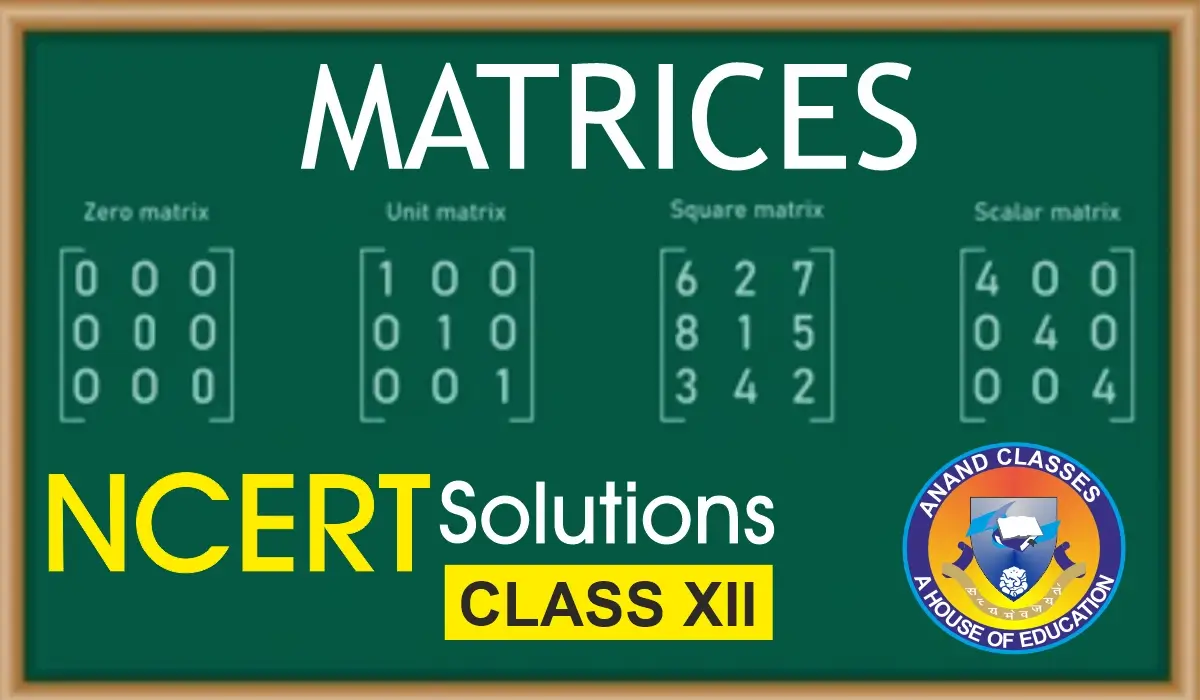Anand Classes provides carefully curated Periodic Table JEE Main PYQs and Competency Based Questions (CBQs) with detailed solutions to help students strengthen their understanding of chemistry concepts. This study material covers important multiple-choice questions (MCQs) from past years, ensuring that learners practice the most relevant topics for competitive exams like JEE Main. Designed for self-study and classroom learning, these resources will guide students to improve their accuracy and problem-solving skills. Click the print button to download study material and notes.
JEE Main 2024 – Isoelectronic Species and Ionic Radii – Class 11 Chemistry
JEE Main 2024 Question :
The statement(s) that are correct about the species $O^{2-}$, $F^{-}$, $Na^{+}$ and $Mg^{2+}$ are:
(A) All are isoelectronic
(B) All have the same nuclear charge
(C) $O^{2-}$ has the largest ionic radii
(D) $Mg^{2+}$ has the smallest ionic radii
Choose the most appropriate answer from the options given below:
(A) (C) and (D) only
(B) (A), (C) and (D) only
(C) (B), (C) and (D) only
(D) (A), (B), (C) and (D)
Answer : Correct Option – B : (A), (C) and (D) only
Step 1: Concept – Isoelectronic Species
Isoelectronic species have the same number of electrons.
Oxygen ($Z=8$): $O^{2-}$ has $8+2=10$ electrons
Fluorine ($Z=9$): $F^{-}$ has $9+1=10$ electrons
Sodium ($Z=11$): $Na^{+}$ has $11-1=10$ electrons
Magnesium ($Z=12$): $Mg^{2+}$ has $12-2=10$ electrons
Hence, all have 10 electrons. So, Statement (A) is correct.
Step 2: Nuclear Charge Comparison
Nuclear charge depends on the number of protons:
O: 8 protons
F: 9 protons
Na: 11 protons
Mg: 12 protons
Since they are different, Statement (B) is incorrect.
Step 3: Ionic Radius Trend in Isoelectronic Series
In an isoelectronic series, ionic radius decreases with increasing nuclear charge.
Order of nuclear charge:
$$ O (8) < F (9) < Na (11) < Mg (12) $$
$O^{2-}$ has the largest ionic radius → Statement (C) correct
$Mg^{2+}$ has the smallest ionic radius → Statement (D) correct
Final Answer
$$ \boxed{\text{B – (A), (C) and (D) only}} $$
Concept Takeaway
Isoelectronic species = same electrons, but different nuclear charge
Ionic radius trend: larger for lower nuclear charge, smaller for higher nuclear charge
Exam tip: Always check both number of electrons and nuclear charge to decide ionic size
This detailed explanation is helpful for Class 11 Chemistry students preparing for JEE Main. Using chapterwise JEE PYQs and study material, students can understand concepts like isoelectronic species and ionic radii trends effectively. Anand Classes provides structured notes and preparation resources to strengthen your understanding of Classification of Elements and other core Chemistry topics.
JEE Main 2024 – Group 13 Elements – Class 11 Chemistry
JEE Main 2024 Question :
The correct order of the first ionization enthalpy among Group 13 elements is:
(A) Ga > Al > B
(B) Tl > Ga > Al
(C) Al > Ga > Tl
(D) B > Al > Ga
Answer : Correct Option: (B) Tl > Ga > Al
Step 1: Understand Ionization Enthalpy Trends in Group 13 Elements
Ionization enthalpy generally decreases down a group due to increasing atomic size and shielding effect. However, there are exceptions in Group 13 elements (B, Al, Ga, In, Tl) due to the presence of d and f electrons, which have poor shielding effects.
Step 2: Analyze the Specific Trends in Group 13
Boron (B): Has the smallest atomic size and thus the highest ionization enthalpy.
Aluminum (Al): Follows the general trend of decreasing ionization enthalpy from Boron.
Gallium (Ga): Has a higher ionization enthalpy than Aluminum due to the poor shielding effect of its inner d-electrons, leading to stronger attraction of the outer electron by the nucleus.
Thallium (Tl): Has an even higher ionization enthalpy than Indium due to the poor shielding effect of its inner f-electrons (inert pair effect).
Step 3: Determine the Correct Order
Considering these factors, the correct decreasing order of first ionization enthalpy for the elements listed (B, Al, Ga, Tl) is:
B > Tl > Ga > Al
Final Answer
Tl > Ga > Al
Concept Takeaway
- Ionization enthalpy trend exceptions occur in Group 13 due to poor shielding by d and f electrons.
- Exam tip: Always consider inner electron shielding and inert pair effects when analyzing trends in ionization enthalpy.
This explanation is useful for Class 11 Chemistry students preparing for JEE Main. Using chapterwise JEE PYQs and study material, students can understand concepts like ionization enthalpy trends, Group 13 anomalies, and the inert pair effect. Anand Classes provides structured notes and preparation resources to strengthen your understanding of Group 13 Elements and other key Chemistry topics.
JEE Main 2024 – Periodic Properties – Class 11 Chemistry
JEE Main 2024 Question :
Given below are two statements:
Statement I: The correct order of first ionization enthalpy values of Li, Na, F and Cl is Na < Li < Cl < F.
Statement II: The correct order of negative electron gain enthalpy values of Li, Na, F and Cl is Na < Li < F < Cl.
In the light of the above statements, choose the correct answer from the options given below:
(A) Statement I is true but Statement II is false
(B) Both Statement I and Statement II are false
(C) Statement I is false but Statement II is true
(D) Both Statement I and Statement II are true
Answer: Correct Option: (D) Both Statement I and Statement II are true
Step 1: Analyze Statement I – Ionization Enthalpy Trend
- Ionization enthalpy increases across a period (left to right) due to decreasing atomic size and stronger nuclear charge.
- Ionization enthalpy decreases down a group due to increasing atomic size and shielding effect.
- Among the given elements:
- $Na < Li$ (because Na is lower in the group than Li).
- $Cl < F$ (because Cl is lower in the group than F).
- So the correct order is:
$$ Na < Li < Cl < F $$
Statement I is correct.
Step 2: Analyze Statement II – Electron Gain Enthalpy Trend
- Electron gain enthalpy becomes more negative across a period (left to right) and becomes less negative down a group.
- Among the given elements:
- Alkali metals (Li, Na) have very low (least negative) electron gain enthalpies.
- Fluorine and Chlorine have highly negative electron gain enthalpies, with Cl being more negative than F due to less electron–electron repulsion in the larger Cl atom.
- Thus, the correct order is:
$$ Na < Li < F < Cl $$
Statement II is correct.
Step 3: Final Evaluation
Since both Statement I and Statement II are correct →
Final Answer
$$ \boxed{\text{Both Statement I and Statement II are true}} $$
Answer: Correct Option: (D) Both Statement I and Statement II are true
Concept Takeaway
- Ionization enthalpy trend: Increases across a period, decreases down a group.
- Electron gain enthalpy trend: Becomes more negative across a period, but within halogens, Cl has more negative value than F.
- Exam tip: Always check exceptions in periodic properties, especially halogens and noble gases.
This concept is essential for Class 11 Chemistry and JEE Main preparation. Practicing PYQs chapterwise with proper explanations helps students understand trends like ionization enthalpy and electron gain enthalpy effectively. Anand Classes provides clear notes and study material to master Periodic Properties for competitive exams.
JEE Main 2024 – First Ionization Enthalpy Property – Class 11 Chemistry
JEE Main 2024 Question :
The correct order of first ionization enthalpy values of the following elements is:
(A) O
(B) N
(C) Be
(D) F
(E) B
Choose the correct answer from the options given below:
(A) A < B < D < C < E
(B) B < C < E < A < D
(C) E < C < A < B < D
(D) B < D < C < E < A
Answer: Correct Option: (C) E < C < A < B < D
Step 1: Understand First Ionization Enthalpy and Periodic Trends
First ionization enthalpy is the energy required to remove one electron from a gaseous atom in its ground state. Generally, ionization enthalpy increases across a period (left → right) due to increasing effective nuclear charge and decreases down a group due to increasing atomic size and shielding. There are important exceptions in the second period.
Step 2: Identify the given elements (all in 2nd period) and electronic configurations
O (Oxygen): $1s^{2}2s^{2}2p^{4}$
N (Nitrogen): $1s^{2}2s^{2}2p^{3}$
Be (Beryllium): $1s^{2}2s^{2}$
F (Fluorine): $1s^{2}2s^{2}2p^{5}$
B (Boron): $1s^{2}2s^{2}2p^{1}$
Step 3: Note the important second-period exceptions
- Be vs B: Be has a filled $2s$ ($2s^{2}$) and is more stable than B which has a single $2p$ electron; hence Be > B in ionization enthalpy.
- N vs O: N has a half-filled $2p^{3}$ (stable), while O has paired electrons in $2p^{4}$ causing extra electron–electron repulsion; hence N > O in ionization enthalpy.
Step 4: Arrange elements using trends and exceptions
General left→right trend in period 2 would be: Be < B < C(—) < N < O < F, but with the known exceptions we get the correct increasing order:
B < Be < O < N < F
Mapping this back to the option labels:
E (B) < C (Be) < A (O) < B (N) < D (F)
Final Answer
Answer: Correct Option: (C) E < C < A < B < D
Concept Takeaway
- Remember the 2nd-period anomalies: Be > B and N > O due to filled and half-filled stability.
- Exam tip: For period-2 elements always check electronic configuration for filled / half-filled stability before applying the simple left→right rule.
JEE Main 2024 – 3rd Ionisation Enthalpy – Class 11 Chemistry
JEE Main 2024 Question:
The transition metal having highest 3rd ionisation enthalpy is:
(A) Mn
(B) Fe
(C) Cr
(D) V
Answer: Correct Option: (A) Mn
Step 1: Recall the concept of 3rd ionisation enthalpy
The third ionisation enthalpy is the energy required to remove the third electron from a gaseous atom. In transition metals, this depends strongly on the stability of the electronic configuration after the removal of electrons.
Step 2: Analyze the given elements
- Mn (Z = 25): [Ar] $3d^{5}4s^{2}$. After losing two electrons → Mn$^{2+}$: [Ar] $3d^{5}$ (half-filled, highly stable). Removing a third electron disrupts this stable half-filled configuration → requires very high energy.
- Fe (Z = 26): [Ar] $3d^{6}4s^{2}$. After losing two electrons → Fe$^{2+}$: [Ar] $3d^{6}$. Removing the third electron → Fe$^{3+}$: [Ar] $3d^{5}$ (half-filled, stable). So 3rd ionisation enthalpy is comparatively lower.
- Cr (Z = 24): [Ar] $3d^{5}4s^{1}$. After losing two electrons → Cr$^{2+}$: [Ar] $3d^{4}$. Removing one more electron gives Cr$^{3+}$: [Ar] $3d^{3}$, not especially stable. Energy required is lower than Mn.
- V (Z = 23): [Ar] $3d^{3}4s^{2}$. After losing two electrons → V$^{2+}$: [Ar] $3d^{3}$. Removing one more electron → V$^{3+}$: [Ar] $3d^{2}$. No special stability, so energy required is lower than Mn.
Step 3: Conclusion
Since Mn$^{2+}$ has a stable half-filled $3d^{5}$ configuration, removing the third electron requires breaking this stability, making Mn’s 3rd ionisation enthalpy the highest among the given options.
Final Answer
Answer: Correct Option: (A) Mn
Concept Takeaway
- Half-filled ($d^{5}$) and fully filled ($d^{10}$) configurations are extra stable.
- If ionisation breaks a stable configuration, the required energy is exceptionally high.
- In JEE, always compare ionisation enthalpy trends using stability of subshells.
JEE Main 2024 – Metals and non-metals Periodic Properties – Class 11 Chemistry
JEE Main 2024 Question:
Given below are two statements:
Statement (I): Both metals and non-metals exist in p and d-block elements.
Statement (II): Non-metals have higher ionisation enthalpy and higher electronegativity than the metals.
In the light of the above statements, choose the most appropriate answer from the options given below:
(A) Both Statement I and Statement II are false
(B) Both Statement I and Statement II are true
(C) Statement I is false but Statement II is true
(D) Statement I is true but Statement II is false
Answer: Correct Option: (C) Statement I is false but Statement II is true
Step 1: Analyze Statement (I)
Statement (I) claims that both metals and non-metals exist in the p-block and d-block elements. This is false because:
- The p-block indeed contains metals, non-metals, and metalloids.
- The d-block, however, consists only of transition metals, with no non-metals present.
Step 2: Analyze Statement (II)
Statement (II) says that non-metals have higher ionisation enthalpy and higher electronegativity than metals. This is true because:
- Ionisation enthalpy is higher in non-metals since their atoms are smaller and the nucleus exerts a stronger pull on electrons.
- Electronegativity is also higher in non-metals as they have a greater tendency to attract electrons in chemical bonding compared to metals.
Step 3: Conclusion
- Statement (I) is false.
- Statement (II) is true.
Therefore, the most appropriate answer is (C).
Final Answer
Answer: Correct Option: (C) Statement I is false but Statement II is true
Concept Takeaway
- The p-block shows the widest variety of elements: metals, non-metals, and metalloids.
- The d-block contains only metals (transition elements).
- Non-metals generally have higher ionisation enthalpy and electronegativity than metals due to smaller atomic radii and stronger effective nuclear charge.
Understanding these differences between blocks and periodic trends in properties like ionisation enthalpy and electronegativity is crucial for Class 11 Chemistry and JEE preparation. With systematic practice of JEE PYQs and Anand Classes study material, students can strengthen their grasp on periodic table and periodicity for better performance in competitive exams.
JEE Main 2024 – Electron Gain Enthalpy Property– Class 11 Chemistry
JEE Main 2024 Question:
The correct sequence of electron gain enthalpy of the elements listed below is:
A. Ar
B. Br
C. F
D. S
Options:
(A) A > D > C > B
(B) A > D > B > C
(C) D > C > B > A
(D) C > B > D > A
Answer: Correct Option: (B) A > D > B > C
Step 1: Recall the Concept
Electron gain enthalpy is the energy change when an electron is added to a neutral gaseous atom.
- Across a period: electron gain enthalpy becomes more negative (more energy released).
- Down a group: it becomes less negative due to larger size and weaker nuclear attraction.
- Noble gases (like Ar) have positive values because adding an electron requires energy.
Step 2: Analyze Each Element
- Argon (Ar): Noble gas, stable configuration, positive electron gain enthalpy (least favorable).
- Sulfur (S): Group 16 element, releases energy when it gains an electron.
- Bromine (Br): A halogen (Group 17), high electron gain enthalpy but smaller in magnitude than Fluorine due to its larger atomic size.
- Fluorine (F): Very electronegative, high electron affinity. However, due to its small atomic size and inter-electronic repulsion in the compact 2p orbital, its electron gain enthalpy is slightly less negative than chlorine but still more negative than Br and S.
Step 3: Arrange in Correct Order
From least negative (most positive) to most negative:
$$ Ar > S > Br > F $$
That corresponds to:
A > D > B > C
Final Answer
Answer: Correct Option: (B) A > D > B > C
Concept Takeaway
- Noble gases have positive electron gain enthalpies.
- Group 16 and Group 17 elements have highly negative electron gain enthalpies.
- Fluorine has slightly less negative electron gain enthalpy than chlorine due to inter-electronic repulsions, but still more negative than bromine and sulfur.
Mastering periodic trends like electron gain enthalpy helps in Class 11 Chemistry and is often tested in JEE PYQs. Preparing with Anand Classes notes and periodic table trends ensures clarity for competitive exams.
📚 Buy Study Material & Join Our Coaching
For premium study materials specially designed for JEE, NEET, NDA, and CBSE/ICSE Classes, visit our official study material portal:
👉 https://publishers.anandclasses.co.in/
For NDA Study Material, Click Here
For SSC Study Material, Click Here
To enroll in our offline or online coaching programs, visit our coaching center website:
👉 https://anandclasses.co.in/
📞 Call us directly at: +91-94631-38669
💬 WhatsApp Us Instantly
Need quick assistance or want to inquire about classes and materials?
📲 Click below to chat instantly on WhatsApp:
👉 Chat on WhatsApp
🎥 Watch Video Lectures
Get access to high-quality video lessons, concept explainers, and revision tips by subscribing to our official YouTube channel:
👉 Neeraj Anand Classes – YouTube Channel


